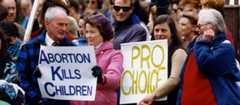Kōrero: Abortion

Abortion has long been a political hot potato. On one side of the debate are people who believe abortion is murder, and on the other are those who believe a woman has the right to control her own body. The issue was most heated in the 1970s and 1980s, when both sides staged protest marches and lobbied Parliament. In the early 21st century the debate warmed up again, with anti-abortion groups making legal challenges and pro-abortion groups pushing for decriminalisation, which was achieved in 2020.
He kōrero nā Megan Cook
Te āhua nui: Anti-abortion and pro-choice protesters
He kōrero whakarapopoto
Abortion is the deliberate ending of a pregnancy. Until the late 1930s this was illegal unless the woman’s life was in danger if the pregnancy continued. After that it was allowed only when the woman’s life or mental health was in danger. Abortion was still strongly disapproved of.
Back-street abortions
Because of the difficulty of getting a legal abortion, many women had illegal abortions. They usually wanted them because they were unmarried or could not cope with more children. Women either caused a miscarriage themselves or paid someone else for an abortion. This could be dangerous, and many women died after or were injured by botched abortions.
How many women had illegal abortions is unknown. Statistics of women who went to hospital after an abortion went wrong show that in 1934 at least 42 died.
For and against
Because back-street abortions were so dangerous, some people argued that safe abortions should be more widely available. Others believed that abortion was morally wrong, or was to blame for the falling birth rate.
From the late 1960s the issue became heated as attitudes to sex and women’s rights changed. Groups on either side of the debate became organised, held protests and lobbied the government.
Changing law
From 1974 to 1983 there were law changes related to abortion, and a royal commission looked into the issue. After the Contraception, Sterilisation, and Abortion Act 1977, a woman could only get an abortion if two doctors agreed that the pregnancy threatened her physical or mental health. Hospital boards set up abortion clinics and had to fund lawful abortions.
In practice, it became easier for a woman to get a legal abortion, but she was reliant on doctors’ interpretation of the law. Abortions that were not approved by the new system remained illegal.
The debate in the 21st century
Activism for and against abortion waned in the 1990s, but re-emerged in the 2000s when newly formed anti-abortion groups used the courts to challenge the status quo. In the 2010s pro-abortion groups pushed for the decriminalisation of abortion and for it to be available in all regions. In 2020 the Abortion Legislation Act made abortion a health rather than a criminal matter, and made it easier for a woman to get an abortion.
Me pēnei te tohu i te whārang
Megan Cook, Abortion, Te Ara – the Encyclopedia of New Zealand, https://teara.govt.nz/mi/abortion (accessed 28 October 2025).
He kōrero nā Megan Cook, i tāngia i te 21 April 2011.




